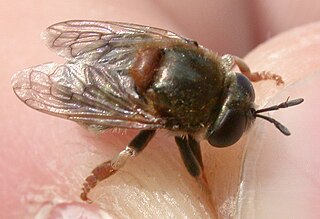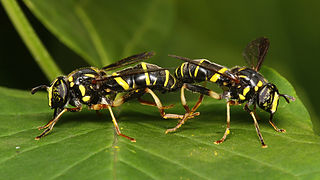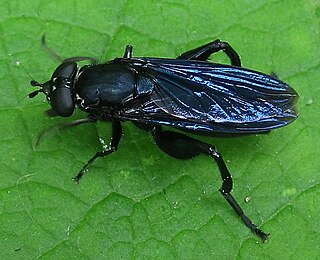
Hover flies of the genus Microdon are unusual among the Diptera. Like other members of the subfamily, they are myrmecophiles, meaning they inhabit the nests of ants.

Xylota is a Holarctic genus of hoverflies similar in structure to the related genera Chalcosyrphus and Brachypalpoides. As the larvae are saprophytic they're usually found in rotting wood. The adult flies are generally associated with woodland and woodland edges and can often be seen running over the upper sides of leaves. Unlike other syrphids the adults of many species rarely visit flowers preferring instead to gather pollen from leaf surfaces. There are over 100 described species of which 12 can be found in Europe. Seven species have been recorded in Britain. Identification of species has been difficult and identifiction by photographs is risky.

Spilomyia is a genus of hoverflies. Many species in the genus show Batesian mimicry of wasp models, including black and yellow patterns and modified antenna shape.

Temnostoma is a genus of hoverflies. The larvae of some species feed on the wood of deciduous trees.

The genus Chrysotoxum consists of large, wasp-mimicking species. The adults are distinguished by very long antennae, oval abdomen with yellow stripes, and yellow patterns on the thoracic pleurae . The species of Chrysotoxum are chiefly Holarctic in distribution. . The species in this genus, are mostly very uniform in structure and colour and are separated with difficulty. Larvae are specialized in preying upon root aphids associated with ant nests.

Platycheirus is a large genus of hoverflies. They are also called sedgesitters.

Criorhina is a genus of hoverflies. Medium to large sized species, black or greenish black, with or without light ground markings mimicking bumblebees. The head is much flattened and broader than the thorax. The antennae are situated upon a prominent conical frontal process, The face is moderately produced below the eyes, downward or forward, in profile. The eyes are bare. The abdomen is elliptical or very short oval. Larvae found in rot holes or decaying hardwoods

Blera is primarily a North American genus, though there are 3 species from Europe. The genus is characterized by the following characters:

Chalcosyrphus is a genus of hoverflies in the subfamily Eristalinae. Many species exhibit some degree of mimicry of various sawflies and other hymenopterans and are often brightly coloured or metallic in hue. The adults are similar in structure and behavior to the related genus Xylota but differ in larval morphology. They can be found throughout Europe, Asia, and North America and seem to prefer damper, boggy habitats. The larvae are saproxylic feeders in rotten wood in these habitats.

Brachyopa is a Holarctic genus of hoverflies whose grey and brown colouration is unusual for this family and these flies can easily be overlooked amongst members of other fly families. The larvae can be found under the bark of dead branches and trees in decaying sap.

These are small black and yellow or mostly black flies with a narrow abdomen near the thorax. They occur mainly in damp places among low herbage. The larva of Neosascia are flattened without oral hooks and a have a short posterior spiracular process or "tail" rat-tailed that is saprophagous. In 1925 Curran reviewed the genus Neoascia. In this work a key is provided and ten species are described including four new species some of which have later been determined to be synonyms.

Orthonevra is a genus of fly in the syrphidae family with at least 59 species identified so far. They are worldwide in distribution but concentrated in the Eastern North America and Europe.Orthonevra are commonly called Mucksuckers after the larvae which have been found in organic rich mud, i.e. muck. This genus belongs to the tribe Brachyopini that includes the prominent genera Melanogaster, Brachyopa, Neoascia and Sphegina. Orthonevra have black heads with blue to purple reflections. Many species have distinctive eye stripes. The antennae are somewhat elongate. The frons is wrinkled with silvery spots at sides of antennae. The thorax with small punctures dorsally and in several species the body is covered with scale-like pile. Wingd vein M1 curves away from the wing tip.(see images)
Mixogaster is a genus of hoverflies native to North America and South America, with 21 known species. Mixogaster is distinct by lacking an appendix on vein R4+5, having a reduced and bare metasternum, an unarmed scutellum, and usually an appendix on vein M extending in cell R4+5. Larvae are found in ant nests.

The Milesiini is a large and diverse tribe of hoverflies. They mimic wasps or hornets.

Milesia is a genus of very large hoverflies, which mimic social wasps. For example, the European species Milesia crabroniformis is a convincing mimic of the hornet species Vespa crabro. Milesia are predominantly Palaeotropical in distribution almost entirely Oriental.

Hadromyia is a genus of hoverflies in the family Syrphidae. There are about seven described species in Hadromyia.
Blerina is a subtribe of hoverfly in the family Syrphidae.
Sterphus is a genus of hoverflies.
Total of 245 species either found or highly expected to be found in New York.














